ENERGY BILLS: SCOTLAND DOES NOT PAY MORE THAN REST OF UK
16 March 2023
The SNP is working hard to push a false narrative that Scots are being “ripped off” or “shafted” on energy bills compared to the rest of the UK. This brief article explains how average energy bills for Scottish households are almost identical to those in the rest of the UK.
Based on actual usage, there is no substance to the claim that Scots face higher bills. In fact, a typical Scottish household pays, per annum, £10 more for gas, but £60 less for electricity, compared to a typical household in the rest of the UK.
Context
On 2nd March 2023, The National newspaper sent an email to its subscribers with the subject line “Scottish customers are being ripped off on energy prices”, encouraging them to read a story headlined:1https://www.thenational.scot/news/23351986.energy-bills-scotland-pay-england/“Energy bills: Why does Scotland pay more than England?”
On 5th March 2023, The Herald on Sunday published a front page splash headlined:2https://www.heraldscotland.com/news/homenews/23363696.scots-set-pay-1000-rest-uk-energy-bills/ "Scots now set to pay £1,000 more than the rest of the UK for energy bills"
SNP MP John Nicholson tweeted an image of the front page, adding “Scotland gets shafted again”.3https://twitter.com/mrjohnnicolson/status/1632152787826950145?s=46&t=y9v1mXDn2DQJqjCpgZcKXg
And on 15th March 2023, the SNP’s Westminster leader Stephen Flynn, said this at Prime Minister’s Questions:4https://hansard.parliament.uk/Commons/2023-03-15/debates/225C92FA-C2BF-44DD-A36B-1D9373CA5EE9/Engagements#contribution-902762A2-9E53-4EEF-9E18-5B64480E592F
“… for households in Scotland energy prices have not been frozen at two and a half grand – indeed, the average bill in Scotland has been closer to £3,500”
Flynn was very likely referencing the Herald On Sunday story, which included this claim in the text of the article:
“A £2,500 price guarantee will mean the typical Scots household will still be forking out close to £3,500 a year in energy bills.”
These Islands has contacted both the Herald on Sunday and Energy Action Scotland (who are quoted in the article) and neither has been able to substantiate this claim (see Addendum).
Analysis
To get to the truth of how energy bills in Scotland compare to the rest of the UK, the question needs to be broken down into three parts: gas tariffs, electricity tariffs, and the number of households relying on oil for central heating.
The UK Government’s Energy Price Guarantee means there is now very little difference between the tariffs available from different suppliers. For the purposes of this analysis, we will use EDF’s published tariff for the period 1st January 2023 - 31st March 2023:5https://www.edfenergy.com/sites/default/files/goelectric_new_epg_prices.pdf
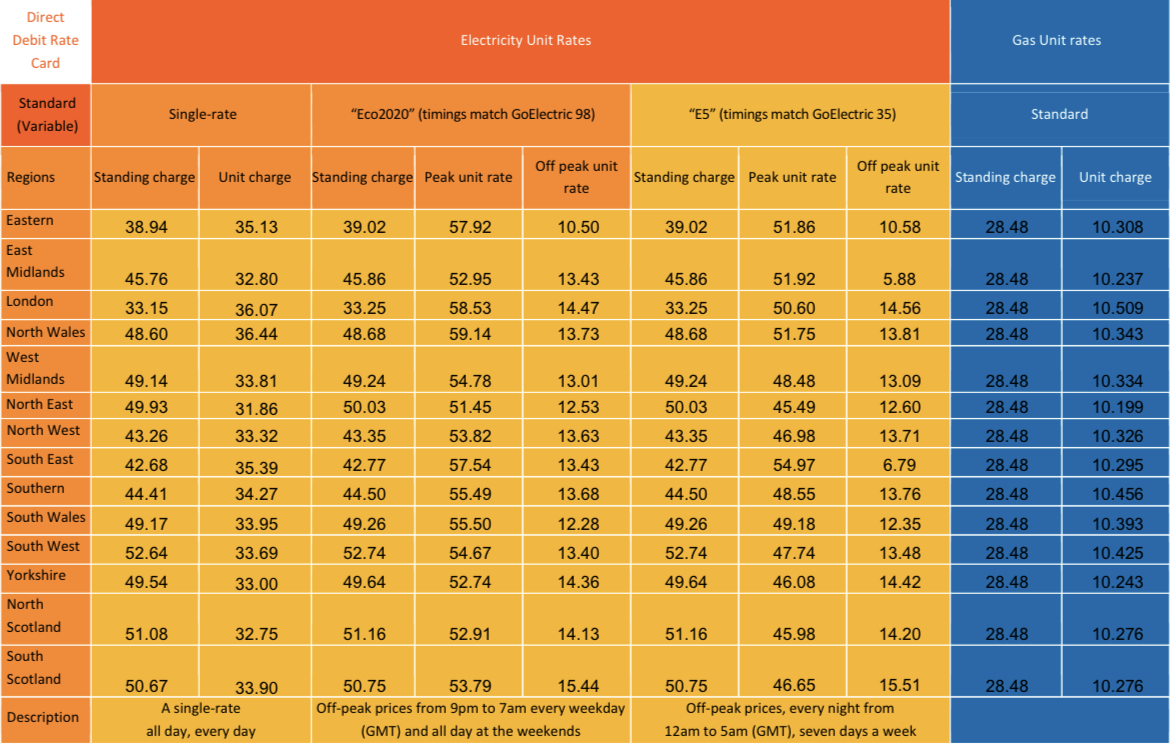
Gas tariffs
Looking at the final two columns of the table above, we can see that standing charges for gas are the same in every region, and unit charges vary only slightly.
Standing charges are fixed daily rates that are payable regardless of usage, and unit rates are what is charged per unit of consumption, measured in kWh.
The average unit charge in GB (excluding Scotland) is 10.339 p/kWh, and in Scotland it is very slightly cheaper at 10.276 p/kWh (simple average of regions, from the data in the EDF tariff table).
So, Scottish households pay a fractionally lower unit rate for gas (0.6% less).
But how much gas does a typical Scottish household use compared to a typical household in the rest of GB?
Here is the data on domestic gas consumption per meter:6https://www.gov.uk/government/statistics/regional-and-local-authority-gas-consumption-statistics
Median
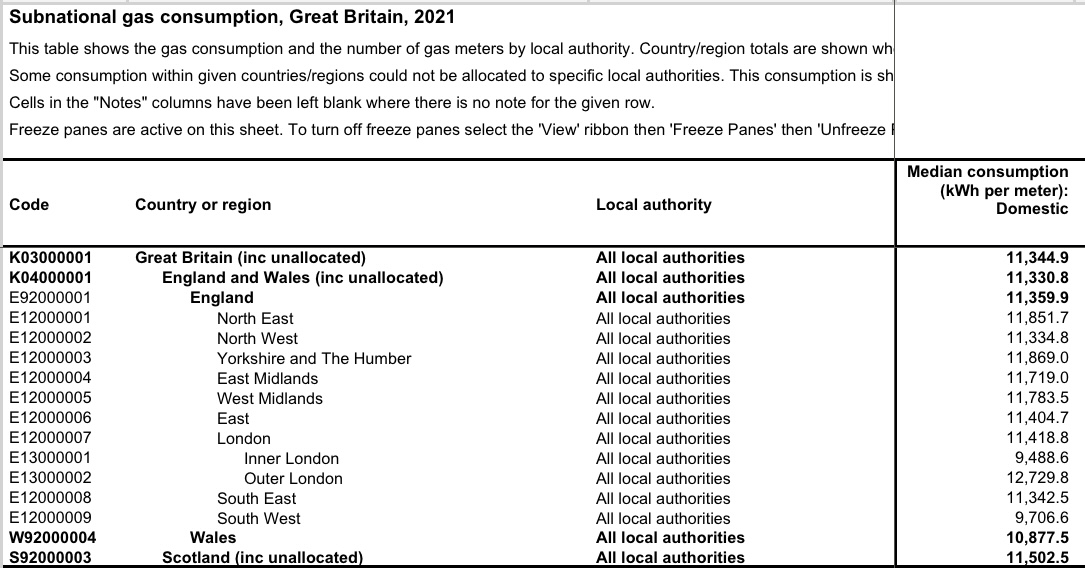
Mean
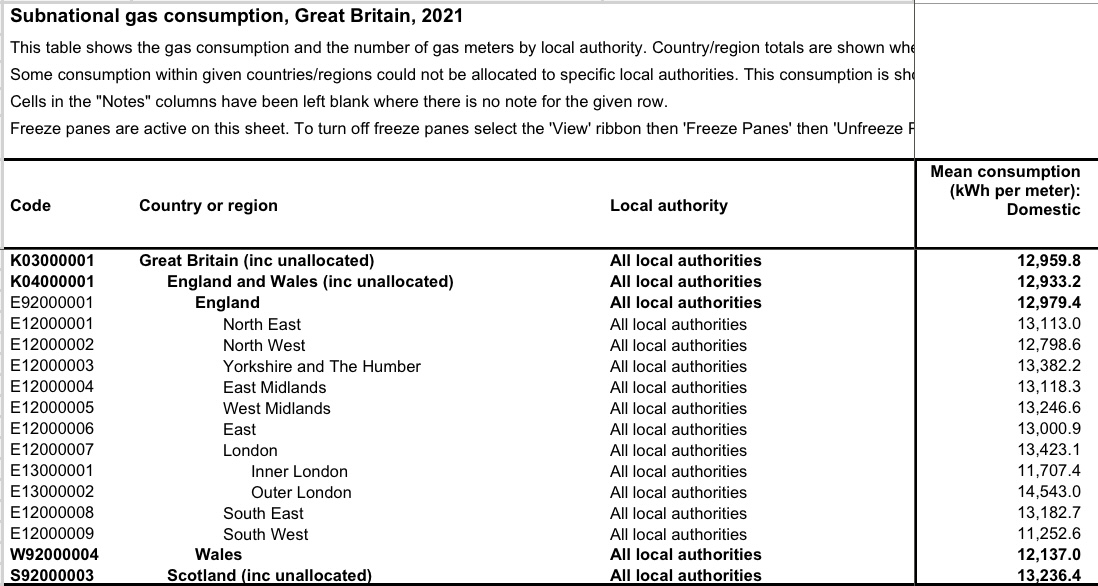
The median Scottish household uses 1.4% more gas than the GB average, and the mean Scottish household uses 2.1% more.
Applying the relevant tariffs to median consumption shows that in absolute terms, a typical Scottish household connected to the gas grid pays about £10 more per annum than the typical GB household.7https://docs.google.com/spreadsheets/d/18ptbApoIGNGyNNi4zAfXnAQzycUSbHG5Z4-GWJ-Z4Dw/edit(Gas tariffs tab) That's effectively the price of Scottish weather. Not a scandal. And not something that would change with independence.
Electricity tariffs
For electricity we will look at the “single-rate” figures in the first two columns of the EDF tariff table. For other types of tariff, the numbers would be slightly different, but the argument is essentially the same.
Electricity tariffs have greater regional variation than gas, in both standing and unit charges.
The average tariffs (simple average of regions, from the data in the EDF tariff table) are:
GB (excluding Scotland)
Standing charge: 45.60 p/day
Unit charge: 34.14 p/kWh
Scotland
Standing charge: 50.88 p/day
Unit charge: 33.33 p/kWh
In Scotland, standing charges are 5.27 p/day higher than in the rest of GB, but unit rates are 0.82 p/kWh lower.
This means tariffs in Scotland are cheaper provided a household uses more than 6.44 kWh (= 5.27 / 0.82) of electricity per day.
So, Scottish tariffs become cheaper at 6.44 x 365 = 2,349.7 kWh per annum.
How much electricity does the typical Scottish household use?
Here is the data on domestic electricity consumption per meter:8https://www.gov.uk/government/statistics/regional-and-local-authority-electricity-consumption-statistics
Median
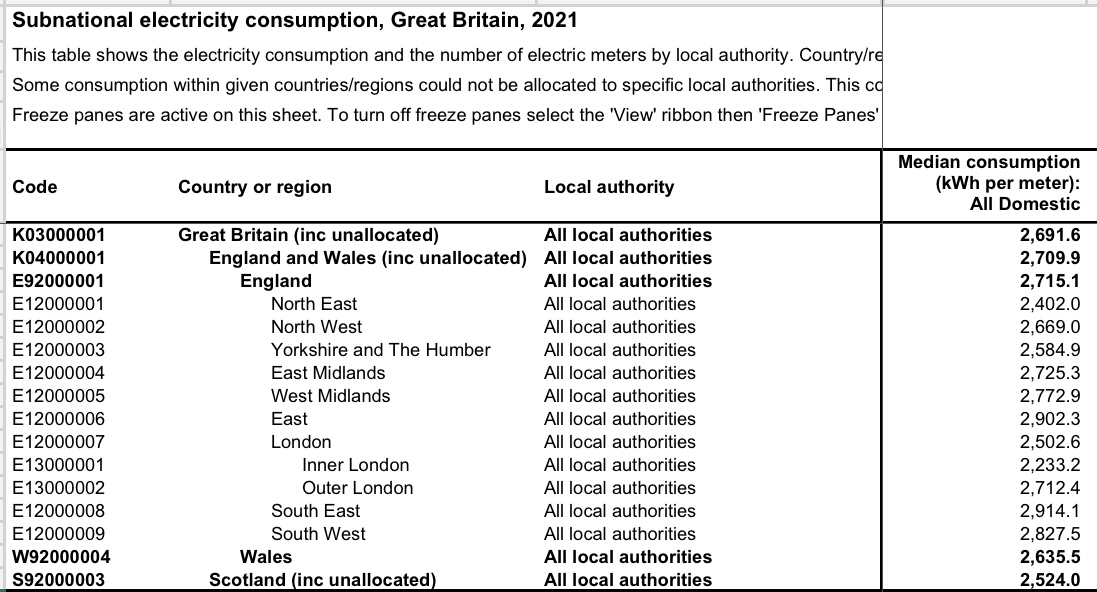
Mean
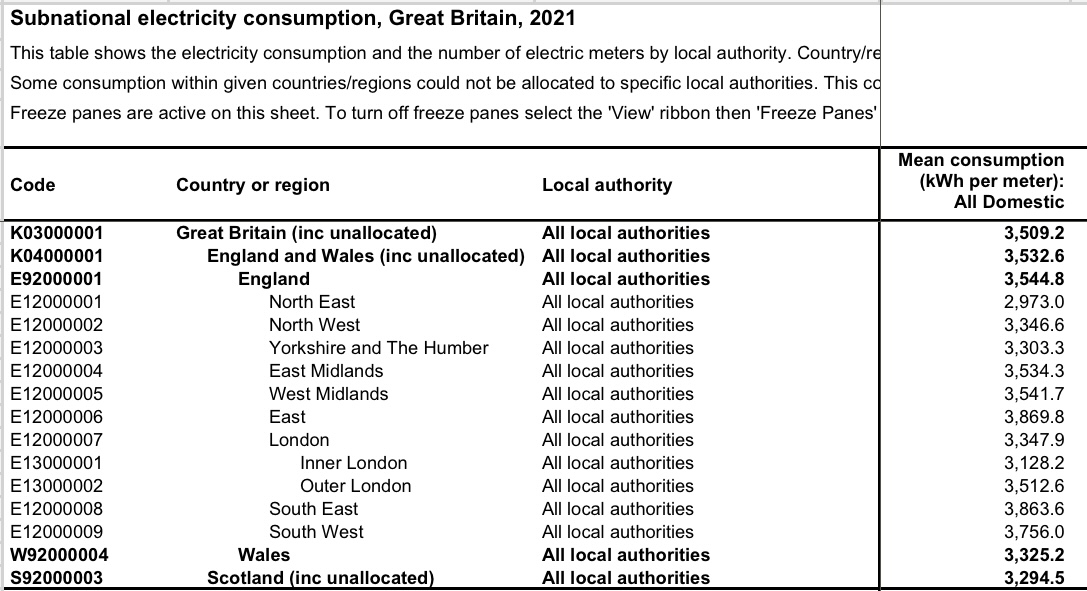
So, both the median and mean Scottish household use comfortably more than the amount of electricity at which the Scottish tariff becomes cheaper. But, in contrast to gas, the typical Scottish household actually uses less electricity than the GB average (about 6% less, on a median or mean basis).
Applying the relevant tariffs to median consumption shows that in absolute terms, a typical Scottish household pays about £60 less per annum than the typical GB household for electricity.9https://docs.google.com/spreadsheets/d/18ptbApoIGNGyNNi4zAfXnAQzycUSbHG5Z4-GWJ-Z4Dw/edit (Electricity tariffs tab)
So, a typical Scottish household is, per annum, £10 down on gas, but £60 up on electricity.
Off gas grid households relying on oil for heating
Some households, particularly in very rural areas, are not connected to the gas grid, and rely on oil for central heating. They have been hit particularly hard by recent fuel price rises because the price of heating oil is unregulated, and falls outside the UK Government’s Energy Price Guarantee (although other schemes do exist to mitigate costs for these households).
The Herald on Sunday article states that there are 129,000 such households in Scotland. The figure is unsourced but looks to come from the Scottish House Condition Survey: 2019, published by the Scottish Government in December 2020 and the most recent edition available.10https://www.gov.scot/publications/scottish-house-condition-survey-2019-key-findings/pages/4/ This is not as robust as census data, but Scotland’s 2022 census was beset with problems and the data is not yet published.
129,000 is 5% of Scotland’s total households.
What the Herald on Sunday article doesn’t mention is that we know from the 2021 census11https://docs.google.com/spreadsheets/d/18ptbApoIGNGyNNi4zAfXnAQzycUSbHG5Z4-GWJ-Z4Dw/edit (Heating oil tab) in England Wales, and Northern Ireland that there are 1.25 million households in the rest of the UK who rely on oil for central heating.
Which, coincidentally, is about 5% of total households in the rest of the UK.
So, the percentage of households in Scotland impacted by the particular issues with heating oil is about the same as the percentage impacted by the same issue in the rest of the UK.
The Herald on Sunday headline would have been much more honest if it had read:“A small number of Scots will pay more than most other Scots for energy bills. Situation very similar in the rest of the UK.”
The Energy Price Guarantee
The UK Government’s Energy Price Guarantee is sometimes described as a cap on energy bills, but that’s not correct. The £2,500 “price guarantee” is based on Ofgem’s typical usage assumptions.12https://www.ofgem.gov.uk/information-consumers/energy-advice-households/average-gas-and-electricity-use-explained
The assumption is per annum consumption in a typical dual-fuel household of 12,000 kWh of gas and 2,900 kWh of electricity.
Based on Ofgem’s assumed consumption, a typical Scottish household pays £2,489. And based on actual median consumption (which is slightly lower in Scotland than Ofgem’s assumptions, for both gas and electricity) the typical Scottish household pays £2,313.13https://docs.google.com/spreadsheets/d/18ptbApoIGNGyNNi4zAfXnAQzycUSbHG5Z4-GWJ-Z4Dw/edit (Gas and Electricity tariffs tabs)
In both cases - Ofgem’s assumptions or actual median consumption - the typical Scottish household pays less than an equivalent household in the rest of the UK.14The ONS publishes annual survey data: Family spending in the UK. The most recent edition covers the year to March 2021, ie well before the energy crisis. It shows a very similar picture: Scotland’s average household energy bill in that period was very close to the UK average (just 3% higher). https://www.ons.gov.uk/peoplepopulationandcommunity/personalandhouseholdfinances/expenditure/bulletins/familyspendingintheuk/april2020tomarch2021
So it wasn’t just the headline in the Herald on Sunday that was false, but the copy of the article too, which included this key claim:
“A £2,500 price guarantee will mean the typical Scots household will still be forking out close to £3,500 a year in energy bills.”
Conclusion
Typical Scottish households pay slightly less than typical households in the rest of the UK for energy bills. Atypical households (ie those in a particular predicament because of reliance on heating oil) are no more prevalent in Scotland than in the rest of the UK.
Addendum
These Islands contacted the Herald on 6th March 2023, the day after the article was published, to ask how it could be justified. We received a reply which stood by the story, and said:
“The headline is justifiable because Scots are now set to pay £1,000 more than the rest of the UK – just not all of them – around 400,000 homes which is explained within the copy as you acknowledge yourself.”
This response does not justify either the headline or the claimed £3,500 energy bill for “the typical Scots household” (and These Islands had made no such acknowledgement). The Herald has not responded since a draft of this article was shared with them on 9th March 2023.
These Islands has also contacted Energy Action Scotland - the only source mentioned in the Herald on Sunday article. Energy Action Scotland deny being the source for the specific claims debunked in this article:15Email to author, 9th March 2023, from Communications and Public Affairs Manager, Energy Action Scotland
“We didn’t state the £1000 difference in the Herald. That is the Herald’s analysis and is based on the dual fuel consumption data.”
Postscript
Following the publication of this article, an upheld IPSO complaint brought by These Islands forced the Herald on Sunday to publish a correction. The story of that saga can be read here.
And the full narrative of the IPSO Complaints Committee decision is here.
Please log in to create your comment